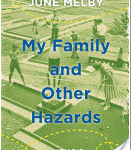 I’ve played it. And so have you, probably. But if you’re like me, you’ve given the mini-golf course and the people who run it almost no thought. That will change when you pick up June Melby’s entertaining and loving memoir of her family’s Tom Thumb Mini Golf course, “My Family and Other Hazards.”
I’ve played it. And so have you, probably. But if you’re like me, you’ve given the mini-golf course and the people who run it almost no thought. That will change when you pick up June Melby’s entertaining and loving memoir of her family’s Tom Thumb Mini Golf course, “My Family and Other Hazards.”
Melby’s parents were schoolteachers in a small Iowa town. One summer they bought a mini golf course, and every summer after, starting when Melby was 11, they packed up their three girls and spent the summer running a Wisconsin mini golf. It was an unlikely purchase for a farm boy who became a teacher of physics and chemistry and a school librarian, and Melby wonders what her parents could have been thinking. It was lots and lots of fun, but running Tom Thumb required a great deal of hard work, and the three girls were required to do their share of it: selling tickets, selling snacks, painting, and covering up hazards when it rained.
Hazards. That’s the technical term for the obstacles on the course, and provide Melby’s work with its structure. Each of the 18 hazards has a name and a story, and each becomes a chapter. Each hazard also provides an abstraction that Melby uses as a jumping off point into the themes she explores: family, work and fun, love, among others.
Hole #5, for example is the Horse. It’s a child’s rocking horse, and the person who built the course cut off the springs and placed it there. “Duct tape holds the horse together. Also, fiberglass, paint, and cement on the back . . . “ Melby writes. “A forty-pound toddler would crack the thing now. It is an artifact, perhaps, something for a museum. Or a dumpster.” Hole # 5 is about history – mini golf was invented in the 1920s, an offshoot of real golf that an enterprising resort owner built, perhaps to keep the wives and children of his golfers entertained. It took off in the 1930s. Melby also explains the origins of Putt-Putt golf, if you’ve ever wondered (I have).
Melby’s father experimented with the hazards, designing and building new ones, trying out with colored lights, barrels, and other unexpected items. Melby and her sisters grew up on the course, where they learned to be independent, discovered the benefits of taking initiative, and observed a lot of boys. Their mother learned the hard way (intoxicants) to be specific about signage. They all study the intricacies of cotton candy, popcorn, and sno-cones. Melby zig-zags between her own and the family’s history, including, for example, a story of a gig doing stand-up at a nudist colony. And then comes Hole #16, the Weird Blue Pipe Thing, and Melby’s bewilderment at her reaction to her parents’ decision to sell the mini golf.
Melby’s narrative circles through her themes, and she touches on her parents and sisters, their lives, and her own. She’s particularly good at capturing a person or type of person. One day a week every summer a group of boys from the boys camp across the lake canoed over to play mini golf.
Forty to fifty boys carried their leftovers on paper plates to our dog, Bo. ‘Please don’t feed the dog,’ we would say, but each week they were different boys, and each was away from home and his own beloved dog, and each felt a need to spoil our dog instead; to tickle his ears and tell him he was good-looking, and see if he liked to eat cotton candy (just a little) or popcorn (quite a lot).
“My Family and Other Hazards” is exceptionally funny and well-written, and worth your time. One of my favorite bits is the way Melby captures the middle-child experience. What’s yours? Let us know that, or tell us about your favorite mini golf memory, in the comments.
Have a book you want me to know about? Email me at asbowie@gmail.com. I also blog about metrics at asbowie.blogspot.com.


